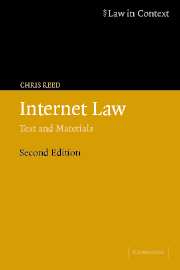Book contents
- Frontmatter
- Contents
- Preface
- Table of UK Statues
- Table of statutes–foreign jurisdictions
- Table of European Communities legislation
- Table of Conventions and Agreements
- Table of cases
- Introduction
- 1 The Internet as a distributed environment
- 2 From each according to his ability : actors and activities in the Internet world
- 3 An infinity of scarce resources : ownership and use of Internet resources
- 4 New actors on a new stage : intermediary liability in the Internet world
- 5 On the Internet, nobody knows you're a dog: identity and identification
- 6 Old wine in new bottles : traditional transactions in the Internet environment
- 7 The long arm of the law : cross-border law and jurisdiction
- 8 Legislative and regulatory arbitrage
- 9 Enforceability in the Internet environment
- 10 Facing the legislative and regulatory challenge
- Index
2 - From each according to his ability : actors and activities in the Internet world
Published online by Cambridge University Press: 05 June 2012
- Frontmatter
- Contents
- Preface
- Table of UK Statues
- Table of statutes–foreign jurisdictions
- Table of European Communities legislation
- Table of Conventions and Agreements
- Table of cases
- Introduction
- 1 The Internet as a distributed environment
- 2 From each according to his ability : actors and activities in the Internet world
- 3 An infinity of scarce resources : ownership and use of Internet resources
- 4 New actors on a new stage : intermediary liability in the Internet world
- 5 On the Internet, nobody knows you're a dog: identity and identification
- 6 Old wine in new bottles : traditional transactions in the Internet environment
- 7 The long arm of the law : cross-border law and jurisdiction
- 8 Legislative and regulatory arbitrage
- 9 Enforceability in the Internet environment
- 10 Facing the legislative and regulatory challenge
- Index
Summary
The process of mapping the flow of internet communications and determining the roles played by the actors in a transaction is complex, even in the simplest of cases. This is because it is almost never true that only two parties are involved. Every internet transaction requires the participation of multiple intermediaries, and may well involve more than two actors. Each of these plays its own part in carrying out the transaction.
From the perspective of the naïve observer, it may not be at all obvious that multiple parties are involved, or what their roles are. A legal analysis of the internet transaction, however, requires an understanding of all those whose activities play a part in the transaction. It is perfectly possible that some action which appears to have been performed by X was in fact carried out by Y, and this will clearly be relevant to the rights and obligations of those involved.
To clarify the investigation of these players and their roles, this chapter will make frequent reference to a simple, hypothetical transaction in which software is sold on-line. In the physical world this transaction is comparatively simple. The buyer enters a shop, agrees to buy the software from the seller, hands over cash, and leaves in possession of a copy of the software. The Internet equivalent is at first sight nearly as simple.
- Type
- Chapter
- Information
- Internet LawText and Materials, pp. 24 - 39Publisher: Cambridge University PressPrint publication year: 2004



